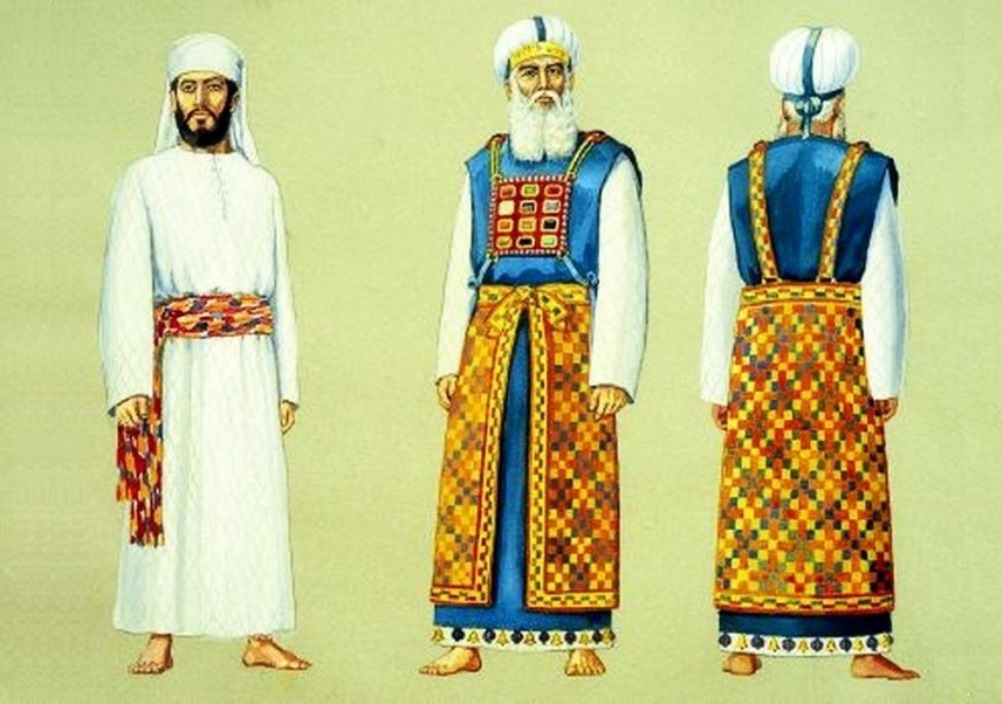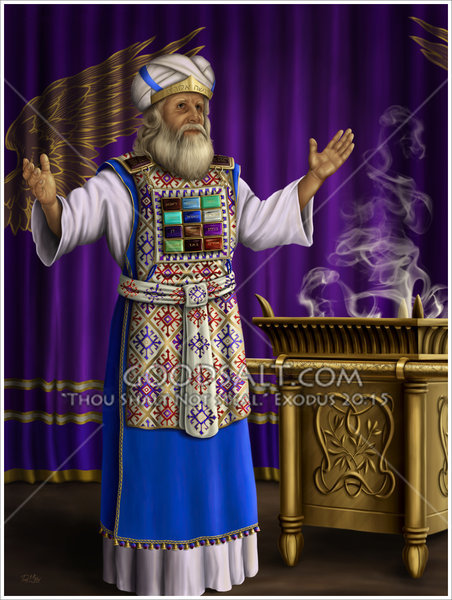In the Old Testament, the high priest was an important religious figure in Israel. The high priest’s garments were very sacred and held a lot of importance. God told Moses to make the garments for Aaron, who would be the first high priest. Join in as we review the High Priest Garments in the Old Testament, holy garments in the Bible, and the meaning of high priest garments.
The material used for Aaron’s robe was linen and purple wool. The linen represented purity, while the purple wool represented royalty. The high priest wore a sash around his waist that was made of blue wool and embroidered with bells and pomegranates (which represent fertility). He also wore a breastplate called Urim and Thummim that contained 12 precious stones representing the 12 tribes of Israel. This breastplate was attached to Aaron’s robe using a gold chain so it wouldn’t fall off during ceremonies or rituals performed by him as High Priest.
Right here on Churchgists, you are privy to a litany of relevant information on high priest garments symbolism pdf, high priest garments exodus 28, Aaron’s priestly garments picture, and so much more. Take out time to visit our catalog for more information on similar topics.
Jewish High Priest Garments
The first was a blue robe with golden bells and pomegranates on the hem. The second was the ephod, an apron-like garment with two stones worn on the shoulders that were engraved with the twelve names of the tribes of Israel.
All the priests wore linen trousers, a tunic, a girding sash, and a turban; over the tunic, the high priest wore a robe, the ephod, the shoulder pieces, and the breastplate, and on the turban, he wore an engraved plate (see Exo. 36-42; 29:5-9).

The high priest also wore a turban that had four horns on it—two on each side—representing power over evil spirits as well as wisdom and strength for protection against enemies who might try to harm them during times of war or conflict between nations during wartime situations.”
The Old Testament is filled with stories, and some of those stories are about priests. Priests were important in the lives of people in the Bible because they served as a link between God and people. Some of these priests wore special clothes that were made just for them, and these clothes had certain meanings that helped the priest be closer to God.
The high priest was one of the most important people in Israel’s society. He was responsible for leading the ceremonies at the temple and making sure everyone was following God’s rules. The high priest wore special clothing at all times. His coat was made out of linen, which came from Egypt and was imported into Israel by boat (Exodus 28:6). The purpose of this material was to remind him that his responsibility is to always be available to serve God’s people (Exodus 28:41). This linen must not be cut or torn because it serves as a reminder for him not to damage his relationship with God through sin (Leviticus 10:3).
The high priest also wore an embroidered breastplate over his heart area. It had four rows of jewels across its center to symbolize how Christ has given us access to heaven through His sacrifice (Exodus 28:17–20). This symbolized that Christ
High Priest Garments in Old Testament
Poor Aaron. He was appointed High Priest of the Israelites by God, but his job wasn’t all shiny gold and embroidered glory. In fact, there were a lot of things he had to wear that were super uncomfortable. You see, the High Priest’s garments were meant to signify something about who God is and Jesus in the future. Since God can be a little tough for us to understand, we can look at these weird things as a sort of symbolism for what serves as our connection to God—the High Priest Bible verse! Let’s take a moment to break down exactly how much thought went into designing all this stuff so that we can get a clearer understanding of who Jesus is to us today.
The High Priest was known for the fine linen garments he wore.
The high priest’s garments were known for being very fine and made of linen. They consisted of a tunic that wrapped around the body and was tied with a girdle. The high priest wore these garments during the daily service at the Tabernacle and Temple. The linen breeches were tied to the tunic and covered his legs up to his thighs, with an opening on each side for his feet to go through so he could walk easily (Exodus 28:42).
Copper thread in embroidery area of the ephod.

Copper thread was used in the embroidery area of the ephod. Copper was also used in the hem of the robe and, in some instances, as a cord around which to tie the turban. The color of copper is red or orange-red, which represents God’s glory and holiness (Exodus 28:31; 39:3). This is why it was specifically chosen by God to be used by His priests, as they represented Him before His people.
The high priest had a special relationship with God because he served as a mediator between people and God on their behalf (Leviticus 1:3; 4:35; 16:32; Numbers 18:1–7). As such, he needed more protection from sin than those who were not serving in this capacity. Therefore, his garments were different from those worn by other priests—they were made out of linen instead of woolen cloths that were dyed purple or scarlet red using dye made from animal blood (see Exodus 25), which would absorb impurities through prolonged contact over time. The use of linen prevents this absorption so when these garments are worn, they remain clean longer than other types would allow them too!
The Urim and Thummim were kept in the breastplate.
The Urim and Thummim were kept in the breastplate. The Urim and Thummim were used by the high priest to determine God’s will. They were also used to help the High Priest determine whether someone was guilty or innocent of a crime.
The color blue signified heaven.
Blue is a symbol of heaven, which is where God’s throne resides. In the Old Testament, it was often used to represent God’s glory. The color blue also represents power, justice and holiness, as well as purity and majesty.
The turban included a golden plate engraved with “HOLINESS TO THE LORD”.
The high priest’s turban included a golden plate engraved with “HOLINESS TO THE LORD”. This was to remind the people that their high priest was a representative of God, and as such, he must be kept holy so that his holiness would reflect onto them. In this way, his turban served as a crown of glory and beauty, but it also served as a crown of holiness.
The ‘robe of checker work’ represented the eternity of God’s nature, since it has no beginning or ending.
The robe of checker work represented the eternity of God’s nature, since it has no beginning or ending. The wool was dyed with the juice of a purple plant, which is a dye that never fades or wears out.
The wool was woven into a fabric called “checker work,” which has alternating squares of dark and light colors. This pattern could be thought of as representing the heavenly host—the heavenly beings who surround God’s throne and worship him continually (Revelation 4:4). It also symbolized humanity’s need for redemption from sin by Jesus’ blood shed on Calvary’s cross (1 Peter 1:19).
The High Priest’s tunic was seamless and woven in one piece.
The High Priest’s tunic was woven from linen. It was sewn together in one piece, which meant that it did not have any seams or stitching. This would be a difficult task to accomplish because the fabric had to be woven with an extremely fine yarn on a loom so small that only one person could work it at a time—and even then, they had to be very skilled.
The colors purple, blue, white, and gold represented royalty, heaven, purity, and glory respectively.
In the Old Testament, the colors purple, blue, white and gold represented royalty, heaven (or heaven’s presence), purity, and glory respectively. Each color had a specific purpose in the clothing of Israel’s high priest.
- Purple was the color for the ephod and robe of Israel’s High Priest. It represented his royalty as God’s representative on earth.[1]
- Blue was used in Israel’s turban on top of their headdress because it represents heaven or God’s presence.[2]
- White represented purity or righteousness.[3]
- Gold represented glory.[4]
Signifies being covered with God’s presence and glory.
The high priest’s garments signify being covered with God’s presence and glory. In other words, when God was present with His people in the Tabernacle, He was clothed with a certain type of glory that covered Him like a garment. This glory often manifested itself in a cloud or pillar of fire over the Tabernacle (Exodus 40:34). This tangible aspect of God’s nature—Himself—was seen as part of their worship experience at this time.
God did not intend for only one man to wear this covering; rather, He intended for all his people to be covered by His presence as well! The very fact that we can go into His presence today is evidence enough that there is a covering available for us too!
Learning about the High Priest’s garments helps us understand who Jesus is to us today!
Understanding the High Priest’s garments helps us better understand who Jesus is to us today. Jesus is our High Priest, Lord, King and Savior. He is our Advocate, Friend and Bridegroom. He is also our Healer and Provider for those who put their faith in him.
Jewish High Priest Garments
High Priest Garments in Old Testament
In the Old Testament, the High Priest was the only person who could enter God’s presence and represent the people. The High Priest had to be holy and blameless. He had to wear five pieces of clothing when he functioned in his office:
Ephod—a robe that covered his entire body
Breastplate—a piece of armor with 12 precious stones representing the tribes of Israel (the stones were engraved with names)
Urim and Thummim—two precious stones attached to a breastplate worn by the High Priest; they were used to receive answers from God about specific questions
Headdress—a turban made out of linen or wool and decorated with gold threading, embroidered flowers, and colored pomegranates that symbolized fertility and fruitfulness; it also had bells attached so that when he moved, they would make noise
A golden crown inscribed with words from Deuteronomy 28:38-39
Conclusion
In conclusion, the High Priest’s garments are a treasure trove of God’s plan for salvation through Jesus Christ. Not only do they tell us about God as our King, but we also learn about his holiness, perfection and yet His desire to have a relationship with us. We find that He is infinite, pure and glorious in all things. And finally, we see that He wants to cover us with his presence and glory! It’s easy to dismiss this topic as one that is unimportant or not relevant today, but I hope this summary of the OT has shown you otherwise!